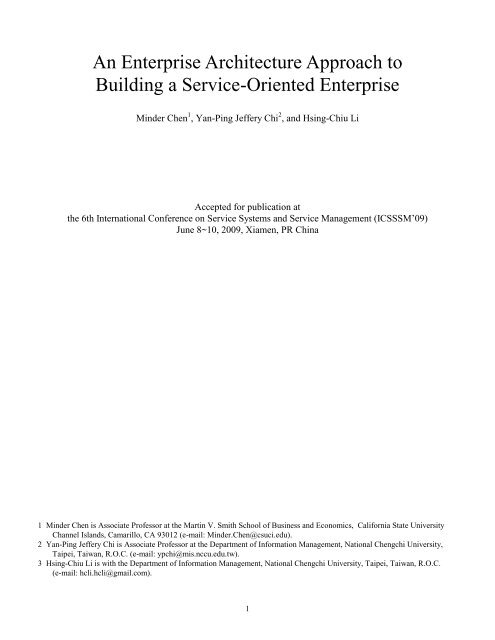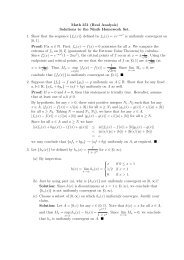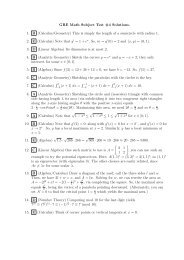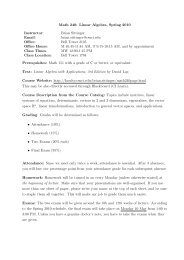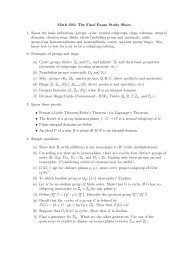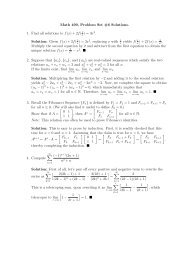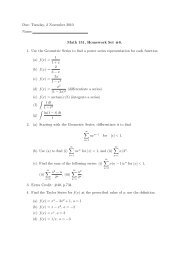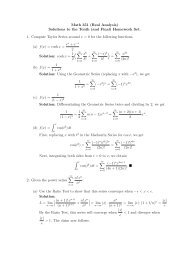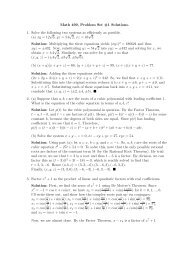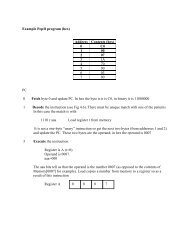An Enterprise Architecture Approach to Building a Service-Oriented ...
An Enterprise Architecture Approach to Building a Service-Oriented ...
An Enterprise Architecture Approach to Building a Service-Oriented ...
Create successful ePaper yourself
Turn your PDF publications into a flip-book with our unique Google optimized e-Paper software.
<strong>An</strong> <strong>Enterprise</strong> <strong>Architecture</strong> <strong>Approach</strong> <strong>to</strong><strong>Building</strong> a <strong>Service</strong>-<strong>Oriented</strong> <strong>Enterprise</strong>Minder Chen 1 , Yan-Ping Jeffery Chi 2 , and Hsing-Chiu LiAccepted for publication atthe 6th International Conference on <strong>Service</strong> Systems and <strong>Service</strong> Management (ICSSSM’09)June 8~10, 2009, Xiamen, PR China1 Minder Chen is Associate Professor at the Martin V. Smith School of Business and Economics, California State UniversityChannel Islands, Camarillo, CA 93012 (e-mail: Minder.Chen@csuci.edu).2 Yan-Ping Jeffery Chi is Associate Professor at the Department of Information Management, National Chengchi University,Taipei, Taiwan, R.O.C. (e-mail: ypchi@mis.nccu.edu.tw).3 Hsing-Chiu Li is with the Department of Information Management, National Chengchi University, Taipei, Taiwan, R.O.C.(e-mail: hcli.hcli@gmail.com).1
<strong>An</strong> <strong>Enterprise</strong> <strong>Architecture</strong> <strong>Approach</strong> <strong>to</strong><strong>Building</strong> a <strong>Service</strong>-<strong>Oriented</strong> <strong>Enterprise</strong>Minder Chen, Yan-Ping Jeffery Chi, and Hsing-Chiu LiAbstract— Several frameworks have been developed <strong>to</strong> assistthe analysis of service management systems. However, most ofthese frameworks only capture limited aspects of aservice-oriented enterprise. This paper first reviews severalpopular service management frameworks. <strong>An</strong> enterprisearchitecture approach that is commonly used in informationsystems planning has been adapted <strong>to</strong> integrate various servicemanagement frameworks and <strong>to</strong>ols, as well as <strong>to</strong> support theplanning and documentation of a service-oriented enterprise. Theproposed service-oriented enterprise architecture (SOEA)includes the following aspects: service, process, people,information, and motivation. Each aspect can be viewed from astrategic, tactical, and operational level. The mapping of theconceptual constructs of existing service management frameworks<strong>to</strong> the proposed SOEA is discussed in detail.Index Terms—<strong>Enterprise</strong> architecture, <strong>Service</strong>-orientedenterprise, <strong>Service</strong> science, <strong>Service</strong> management frameworksSI. OVERVIEW OF SERVICE MANAGEMENT FRAMEWORKSERVICE-ORIENTED architecture (SOA) has the potential<strong>to</strong> support service-oriented enterprise. However, most of theservice analysis and design methodologies for buildingapplications based on SOA are <strong>to</strong>o technically oriented [2].Researchers in the service management fields have identifiedseveral commonly used frameworks or <strong>to</strong>ols that have been usedin service management research and practices [8] [24]. Theseframeworks or <strong>to</strong>ols include:1) The service marketing triangle [4]: It defines relations andpromises among companies, providers, and cus<strong>to</strong>mers, aswell as the marketing efforts among these entities: internalmarketing between company and providers, externalmarketing between companies and cus<strong>to</strong>mers, andinteractive marketing between cus<strong>to</strong>mers and providers.2) Gap model of service and dimension of service quality[23]: The service gap model identifies and explains reasonsfor gaps in service quality. It is used <strong>to</strong> specify fivedimensions for measuring service quality gaps.3) The service profit chain [10]: It establishes a causalrelationships among internal service quality, employeesatisfaction, employee productivity and retention, externalservice value, cus<strong>to</strong>mer satisfaction, cus<strong>to</strong>mer loyalty, aswell as revenue grow and profitability [11].4) The evidence of service from a cus<strong>to</strong>mer’s point of view[3]: It includes people, process, and physical evidence. Thephysical evidence is “the environment in which the service2is delivered and in which the firm and the cus<strong>to</strong>mer interact,and any tangible commodities that facilitate performance orcommunication of the service [24, p. 313].”5) <strong>Service</strong> blueprinting [5]: A process modeling <strong>to</strong>ol foranalyzing service processes. Cus<strong>to</strong>mer activities, activitiesthat are visible and non-visible from cus<strong>to</strong>mer’s viewpoint,and backend activities are identified explicitly in theservice blueprint.These frameworks were developed based on variousdisciplines such as quality improvement programs, operationsmanagement, and service marketing; hence, have differentfocuses on process, people (e.g., cus<strong>to</strong>mer satisfaction), orperformance (i.e., quality standard). These focuses representthe various dimensions of service management. Existingservice frameworks have not incorporated all dimensions ofservice management. They also lack views from variousstakeholders who are concerning with services.In this paper, we have developed a service-orientedenterprise architecture (SOEA) serving as a supra-framework <strong>to</strong>integrate existing service frameworks <strong>to</strong> provide practitioners a<strong>to</strong>ol <strong>to</strong> plan and design all aspects of a service-orientedenterprise. Section II of the paper reviews existing literature ofenterprise architecture and defines the proposed framework.Several important dimensions of the proposed frameworks aredescribed in detail in section III. Directions of future researchare discussed in section IV <strong>to</strong> conclude the paper.II. A SERVICE-ORIENTED ENTERPRISE ARCHITECTUREWe first review the his<strong>to</strong>ry of enterprise architecture (EA)researches and applications, and then discuss the proposedservice-oriented enterprise architecture. Business SystemsPlanning methodology, developed at IBM [22], identifiesproducts/services across four stages of their lifecycle:requirement, acquisition, stewardship, and disposition.Business processes are identified and associated withprocesses/services and are cross-referenced with supportingresources such raw materials, facility, cash, and personnel.Business applications are identified via cluster analysis of theinteractions between data and processes. The methodology hasbeen extended in Information Engineering methodology as anInformation Systems Planning <strong>to</strong>ol which facilitates the creationof information (data) architecture, business systemsarchitecture, and technical architecture [18]. However, theseapproaches are still considered <strong>to</strong> be more technical oriented.Recently the US federal government has developed a Federal
<strong>Enterprise</strong> <strong>Architecture</strong> (FEA) program under its e-Governmentinitiative [14]. The FEA framework is derived from NIST’s<strong>Enterprise</strong> <strong>Architecture</strong> Model as a management <strong>to</strong>ol thatillustrates the interrelationship of enterprise business,information, and technology environments. FEA isbusiness-driven and a set of FEA five reference models has beendeveloped including two very business-oriented models: thePerformance Reference Model and Business Reference Model[14].<strong>Enterprise</strong> architecture was first proposed as an informationsystems planning <strong>to</strong>ol by John Zachman [22]. The initialversion of the architecture contains only Data, Function, andNetwork dimensions of an information system. Zachman andhis colleagues have been extended <strong>to</strong> EA <strong>to</strong> six aspects of anenterprise from various stakeholders’ viewpoints and atdifferent levels of details [19]. The enterprise architectureframework has been used effectively as an information systemsplanning <strong>to</strong>ol <strong>to</strong> ensure consistency among various componentsof an enterprise. The six dimensions or aspects of Zachman’sframework and can be adapted <strong>to</strong> describe services in anenterprise:1) Data (What): What data are needed <strong>to</strong> support theenterprise? To better support cus<strong>to</strong>mer service, one have <strong>to</strong>capture, s<strong>to</strong>re, organize, filter, analyze, and deliverinformation <strong>to</strong> the frontline cus<strong>to</strong>mer facing employees andmanagers <strong>to</strong> handle cus<strong>to</strong>mer requests properly.2) Function (How): This is the process dimension describinghow service is performed or rendered.3) Network (Where): The network dimension reflects thelocations where the enterprise provides its services and thetechnical infrastructure that is required <strong>to</strong> connec<strong>to</strong>perations in these locations <strong>to</strong>gether.4) People (Who): This dimension includes employees,cus<strong>to</strong>mers, managers, and suppliers. All of them need <strong>to</strong> beinvolved in developing a service-oriented enterprise.5) Time (When): This dimension specifies when certainactions need <strong>to</strong> be done.6) Motivation (Why): Organization strategies are translatedin<strong>to</strong> organization goals and key performance indica<strong>to</strong>rs.The performance measures via KPI will be used inevaluating processes and people.We can describe each aspect from the perspective of differentstakeholders, from most abstractive “conceptual viewpoint” <strong>to</strong>the most detailed “implementation view”. The 5W1H labelingof these six dimensions is a very useful in helping us <strong>to</strong> connectthese dimensions <strong>to</strong>gether <strong>to</strong> develop a more integratedenterprise in which everyone know what information they need<strong>to</strong> have, how they should perform their tasks in the context ofcross functional area business processes, where they operate,who are responsible for performing the work for whom, whenthese things need <strong>to</strong> be done, and why these things need <strong>to</strong> bedone in the first place. A successful EA will help <strong>to</strong> transformall aspects of an organization by ensuring consistency among allsix aspects of the architecture and support the viewpoints fromthe <strong>to</strong>p level planner <strong>to</strong> the people who are implementing thedesign at the frontline.However, most EA frameworks have not takenservice-orientation in<strong>to</strong> consideration. They have been used ininformation systems planning, although researchers agree EAsshould not be limited <strong>to</strong> information technology (IT) planningand can be used for enterprise strategy planning. There areseveral frameworks that have been proposed <strong>to</strong> guidecompanies in planning and analyzing their services. However,these frameworks only cover one or two aspects of services inan enterprise. We believe that EA can be extended <strong>to</strong> integratethese major service science frameworks <strong>to</strong> ensure that they areconsistent across various aspects and reflect the viewpoints ofstakeholders at different levels. In our proposedservice-oriented EA, we use three levels of abstraction inviewing these dimensions (aspects):1) Strategic level: This is the view from both planner andcus<strong>to</strong>mers. It is also the most abstract view that representsthe big picture, long term goals, as well as macro-level andvisionary thinking.2) Tactical level: This is the designer’s view of the logicaldesign of the systems across all dimensions.3) Operational level: This is the implementer’s view and it isalso most detailed view. It represents specific objectives,repetitive and very short term operations.These three levels represent a continuum from most abstract<strong>to</strong> concrete view and reflect long-term <strong>to</strong> short-term concerns.Based on extensive literature review in service management, wehave identified five major dimensions for service management:service, information, process, people, and motivation. Aproposed <strong>Service</strong>-<strong>Oriented</strong> <strong>Enterprise</strong> <strong>Architecture</strong> (SOEA),depicted in Table I, is developed based on enterprisearchitecture practices and existing service managementframeworks. The service dimension is created as a main objectin SOEA. The Time and Network dimensions are integratedin<strong>to</strong> other dimensions; hence they are not shown explicitly in theSOEA. In the following sections, we discuss some of theconceptual constructs and models in these dimensions and howthey can be used <strong>to</strong> support a service-oriented enterprise.III. COMPONENTS OF THE SERVICE-ORIENTED ENTERPRISEARCHITECTUREEach dimension of the SOEA is discussed in this section.Each cell in the SOEA framework contains one or moremodeling <strong>to</strong>ols or frameworks. Relationships across thesedimensions are important for integration among variousframeworks.3
TABLE IA SERVICE-ORIENTED ENTERPRISE ARCHITECTUREView <strong>Service</strong> Process People Information MotivationStrategicViewTacticalViewOperationalView<strong>Service</strong>StrategiesA. <strong>Service</strong> Dimension<strong>Service</strong> has many unique features comparing <strong>to</strong> product;hence it requires different approaches <strong>to</strong> service management.<strong>Service</strong> can be broken down in<strong>to</strong> service elements. <strong>Service</strong>strategy will help an organization <strong>to</strong> define high-level servicesfor its cus<strong>to</strong>mers based on its mission and business strategies. Amore concrete service portfolio should be developed based onthe service strategies. Based on ITIL Version 3 [15], serviceportfolio includes service in the pipeline (i.e., under design anddevelopment), operational services in the service cataloguecurrently offered <strong>to</strong> cus<strong>to</strong>mers, and retired services that areobsolete. <strong>Service</strong> catalogue management is the activity <strong>to</strong>ensure that a service catalogue is produced and maintainedproperly so that it contains accurate information on alloperational services [15].<strong>Service</strong> listed at the tactic level can be decomposed in<strong>to</strong> acollection of service elements <strong>to</strong> encourage shared services inorder <strong>to</strong> increase the efficient resource utilization required forservice provisioning. Some of the service elements can beimplemented as Web services <strong>to</strong> enable distributed andcomponent-based information systems under a service-orientedarchitecture [7].B. Process dimension<strong>Service</strong> Portfolio& Catalogue<strong>Service</strong>Operations &Web <strong>Service</strong>s<strong>Service</strong> ValueChainFrameworkCus<strong>to</strong>merManagementActivity Model<strong>Service</strong>BlueprintingCus<strong>to</strong>mer Segmentation& Employee AttributesOrganizationalStructure & HumanWorkflow<strong>Service</strong> Teams &Cus<strong>to</strong>mersAt the strategic level of the SOEA, a business process modelfocusing on a chain of value added macro-level businessprocesses. These processes can be classified in<strong>to</strong> primary valueactivities and supporting value activities. The primary activitiesinclude: inbound logistics, operations (production), outboundlogistics, marketing and sales (demand), and services(maintenance). The original value chain model is more geared<strong>to</strong>wards manufacturing firms and need <strong>to</strong> be adapted <strong>to</strong> use forcompanies in service industry. The primary value activitiesinclude Marketing, Sales, <strong>Service</strong> Rendering, and <strong>Service</strong>Recovery. The service value chain framework extends the valuechain analysis and emphasizes the interactions between theservice purchasing and service rendering from the viewpoint ofboth service consumer and service provider [1]. Bothinformation technology and human resource managementactivities are strategic functions for the development of thenecessary infrastructures <strong>to</strong> support front-line employees and <strong>to</strong>enable the building IT-enabled services.Cus<strong>to</strong>mer management activities can be classified in<strong>to</strong> twomajor categories: cus<strong>to</strong>mer acquisition and cus<strong>to</strong>mer retention.4<strong>Enterprise</strong>-WideConceptual InformationModelLogical Data Model &Dimensional Model of<strong>Service</strong> EventsPhysical Data Model of<strong>Service</strong>s and <strong>Service</strong>ActivitiesVisions, Missions, &Business Strategies<strong>Service</strong> and BusinessGoalsPerformance Measures &<strong>Service</strong> QualityCus<strong>to</strong>mer Management Activity Tool (CMAT) defined adetailed multiple stages of cus<strong>to</strong>mer lifecycle activity modelfrom a service provider’s viewpoint [20]. As depicted in Figure1, this model can be used as a template for service processmodeling and for performance measure. Organizationsperform the following activities according <strong>to</strong> the cus<strong>to</strong>merlifecycle:1) Awareness: This is the first step in the lifecycle. It is theactivity that makes cus<strong>to</strong>mers and potential aware of theservices provided by the organization.2) Targeting: This process involves attracting appropriatecus<strong>to</strong>mers <strong>to</strong> use the services provided by the organization.3) Enquiry management: Manage and work on the leadsgenerated by the targeting efforts. It involves activities thatconvert leads <strong>to</strong> cus<strong>to</strong>mers.4) Welcoming: At this stage, service providers offer orientationof service offerings and contact information for newly joinedcus<strong>to</strong>mer.5) Getting <strong>to</strong> know: Through the use of services or products,companies obtain additional information about cus<strong>to</strong>mers’profiles and their usage patterns of the firm’s products orservices. Cus<strong>to</strong>mers also become more familiar with thefirm’s offerings and processes.6) Account management: This process involves the handling oftypical business transactions and service rendering withcus<strong>to</strong>mers.7) Intensive care: It is the moment of truth when cus<strong>to</strong>mersreally need your assistance in major service events or servicefailures.8) Pre-divorce/Divorce: This is the process that handlescus<strong>to</strong>mers who are quitting from the firm.9) Winback: It involves getting back cus<strong>to</strong>mers who have leftthe firm.At the operational level, a detailed process model for eachmajor cus<strong>to</strong>mer service encounter can be developed <strong>to</strong> supportthe process improvement efforts and <strong>to</strong> develop scripts andguidelines <strong>to</strong> for each activities in the process <strong>to</strong> ensure servicequality standards. The service blueprint is a process modelingtechnique developed <strong>to</strong> support the modeling and analysis ofservice operations [5]: There are five components of a typicalservice blueprint:1) Cus<strong>to</strong>mer actions: Most process modeling technique doesnot take the cus<strong>to</strong>mer actions in<strong>to</strong> consideration.2) Onstage/visible contact employee actions: The interactionbetween cus<strong>to</strong>mers and the frontline workers are the
Fig. 1. Cus<strong>to</strong>mer Activity Lifecycle Modelcus<strong>to</strong>mer <strong>to</strong>uch points that are the “moment of the truth”from the cus<strong>to</strong>mer viewpoint.3) Backstage/invisible contact employee actions: thebackstage actions by contact employees are no lessimportant than the onstage operations. However, they onlyplay a background role and are enabled by operatingsupporting processes.4) Support processes: This is the process that is at thebackground and used by employees at the backstage.5) Physical evidence: The physical evidence is the physicalenvironment and artifacts that may affect the cus<strong>to</strong>mer’simpression on quality service.In ITIL documents describe five service managementprocesses. <strong>Service</strong> strategy represents the process of developingand defining policies and objectives. Continual serviceimprovement represents learning and improvement of allservice related processes. From the viewpoint of serviceportfolio management, we can describe services based on theirservice life cycle stages from the service provider’s viewpoint:<strong>Service</strong> design, <strong>Service</strong> transition, and <strong>Service</strong> operation [15].<strong>Service</strong> strategy is the process that is driving the service design,service transition, and service operation while serviceimprovement process applies <strong>to</strong> all other four processes.1) <strong>Service</strong> strategy is how organizations position themselvesin the marketplace in term of their service offerings. Itprovides guidance on how <strong>to</strong> design, develop, andimplement service management as an organizationalcapability and a strategic asset. <strong>Service</strong> Strategy will beguiding and driving <strong>Service</strong> Design, <strong>Service</strong> Transition,<strong>Service</strong> Operation, and Continual <strong>Service</strong> Improvement.2) <strong>Service</strong> design involves the design, development, andimprovement of existing and new services, as well asservice management processes. It is the process thatconverts strategic objectives in<strong>to</strong> portfolios of services andservice assets. Effective service design makes changes andimprovements necessary <strong>to</strong> increase or maintain value <strong>to</strong>cus<strong>to</strong>mers over the lifecycle of services, the continuity ofservices, achievement of service levels, and conformance<strong>to</strong> standards and regulations.3) <strong>Service</strong> transition involves the development andimprovement of capabilities for transitioning new andchanged services in<strong>to</strong> operations. It ensures that therequirements of <strong>Service</strong> strategy encoded in <strong>Service</strong> designare effectively realized in <strong>Service</strong> operation whilecontrolling the risks of failure and disruption.4) <strong>Service</strong> operation involves achieving effectiveness andefficiency in the delivery and support of services. It iscritical <strong>to</strong> maintain stability in service operations whileallowing for changes in design, scale, scope and servicelevels. <strong>Service</strong> operation covers issues such as managingthe availability of services, controlling demand, optimizingcapacity utilization, scheduling of operations and fixingproblems.5) <strong>Service</strong> improvement process is not limited <strong>to</strong> serviceoperation. It involves creating and maintaining value forcus<strong>to</strong>mers through better service design, transition, andoperation by deploying principles and methods fromquality management, process reengineering, and capabilityimprovement.<strong>Service</strong>s pipeline includes services in the service design andtransition stages while service catalog covers service in thetransition and operation stages. The process frameworkprovided in ITIL is very generic and can be used as a frameworkfor managing service processes for various service industries.The process modeling and management frameworks presentedin SOEA are complimentary <strong>to</strong> each other.C. Information DimensionWe have developed a baseline data model, as depicted inFigure 2, according <strong>to</strong> our analysis of several service industries[9][13]. In order <strong>to</strong> reduce the complexity of the data model, theentity-relationship diagram does not show most of the attributesand many-<strong>to</strong>-many relationships are not decomposed in<strong>to</strong>one-<strong>to</strong>-many relationships. The model illustrates key conceptualconstructs required <strong>to</strong> support the management of informationand knowledge about cus<strong>to</strong>mers, service, and sales:1) <strong>Service</strong> Area. <strong>Service</strong> category is the categorization ofservices <strong>to</strong> be sold. In our data model, the <strong>Service</strong> entitycan be classified in<strong>to</strong> various Category entities. A categorycan be refined in<strong>to</strong> subcategories via the recursiverelationship "has-subcategories." This information allowscus<strong>to</strong>mers <strong>to</strong> drill down through a category hierarchyduring their browsing <strong>to</strong> find services. The <strong>Service</strong> entitymay be further characterized by various attributes.Cus<strong>to</strong>mers often use these attributes as search criteria.Attributes for different types of services may vary. Domainexperts may help <strong>to</strong> identify these attributes in theirindustries. Additional service configuration information isneeded for companies selling cus<strong>to</strong>mized services (e.g., a<strong>to</strong>ur package) that have various optional service items (e.g.,hotel stay, a visit <strong>to</strong> Disneyland, dinner). The <strong>Service</strong>entity can be related <strong>to</strong> the Cross-Sell entity and theUp-selling entity. The cross-selling and up-sellinginformation can be entered manually based on employee'sknowledge about services. Using market-basket analysis,we use cus<strong>to</strong>mer’s service consumption data <strong>to</strong> generatecross-selling and up-selling information [12].2) Cus<strong>to</strong>mers Area. Target marketing and market5
segmentation rely on data about a cus<strong>to</strong>mer's demographicshas subcategories<strong>Service</strong> CategoryCategoryIDdescriptionincludeshasReviewis provided byCus<strong>to</strong>merCus<strong>to</strong>merIDcreatednamestateconsisting of location, lifestyle, and services purchased.For example, a company can use criteria such as recency(how recently cus<strong>to</strong>mers have purchased a company’sservice), frequency, and monetary value <strong>to</strong> segment itscus<strong>to</strong>mers for target marketing [12]. Cus<strong>to</strong>mers' feedbackregarding services is important information that a firmshould collect from its cus<strong>to</strong>mers. This information iscaptured via the Review entity between Cus<strong>to</strong>mer and<strong>Service</strong>.3) Sales Area. Sales data links cus<strong>to</strong>mers <strong>to</strong> services. <strong>Service</strong>ordering records can be used as input <strong>to</strong> facilitatepersonalized interaction with cus<strong>to</strong>mers. By capturing amarketing campaign via the Promotion entity and relating it<strong>to</strong> sales data, companies can analyze the effectiveness ofmarketing campaigns as compared <strong>to</strong> a non-campaignperiod. Sales data can be consolidated in<strong>to</strong> a subject area ofa data warehouse consisting of a service sale fact table andother fac<strong>to</strong>rs defined as dimension that may affect thecus<strong>to</strong>mer’s service purchasing decisions [12]. This is thefirst step <strong>to</strong>wards transforming cus<strong>to</strong>mer data in<strong>to</strong>information and knowledge. We can then use data mining<strong>to</strong>ols <strong>to</strong> analyze the information in the data warehouse <strong>to</strong>create patterns and rules that may explain cus<strong>to</strong>mers'service purchasing behaviors and preferences.D. People Dimensionis used in<strong>Service</strong><strong>Service</strong>ID<strong>Service</strong>StageDate_of_OperationV ersionNumberpromotespurchasesincludesdepends on<strong>Service</strong> Componenthas crosssell serviceshas upsell servicesPromotionpromo_nameservice Orderorder_id<strong>to</strong>talstatusdate_entereddate_changedCross SellCrossSell<strong>Service</strong>IDdescriptionUp sellUpSell<strong>Service</strong>IDdescription<strong>Service</strong> Order Itemquantityadjusted_pricecredit <strong>to</strong>containsFig. 2. A Logical Data Model for Managing Cus<strong>to</strong>mers, <strong>Service</strong>s, and SalesPeople including cus<strong>to</strong>mers and employees, are at the core ofservice delivery. Vargo and Lusch developed aservice-dominant logic for economic activities and marketing[21]. Interactivity, integration, cus<strong>to</strong>mization, andcoproduction are the hallmarks of such a service-centric view.Cus<strong>to</strong>mers are co-producers of service delivery experiences.6<strong>Service</strong> providers and frontline workers who interact withcus<strong>to</strong>mers should have specific personalities so that they areable <strong>to</strong> build rapport with cus<strong>to</strong>mers during the servicedelivery. <strong>An</strong> enterprise should identify segments of cus<strong>to</strong>mersfor their service offerings as well as recruit and train itsemployees with a service-oriented attitude.In a service-oriented enterprise, its business units aredesigned <strong>to</strong> support the frontline workers who interact withcus<strong>to</strong>mers. Human workflow systems need <strong>to</strong> be streamlinedsuch that clear responsibility and authority are defined.Companies should also tap in<strong>to</strong> the flexibility and intelligenceof their employees <strong>to</strong> provide personal and cus<strong>to</strong>mizedservices. Finally, at the operational level, companies may useservice teams <strong>to</strong> ensure that cus<strong>to</strong>mer expectations are fulfilled.E. Motivation DimensionMotivation dimension includes service strategy at thehighest level, service goals at the tactic level, and servicequality (service performance measure) at the operational level.<strong>Service</strong> strategies are supported by service offerings and can bedeveloped based on one of the three generic competitivestrategies: cost leadership, differentiation, and focused market.<strong>Service</strong> goals are defined <strong>to</strong> ensure the successfulimplementation of service strategies. Eventually service qualityis used <strong>to</strong> track the performance specific service process andservice encounter.Measuring the service quality is a very challenge task due <strong>to</strong>the subjective nature of cus<strong>to</strong>mer satisfaction regardingservices. <strong>Service</strong> performances should be defined from thecus<strong>to</strong>mer’s perspective and should include both hard measuresand soft measures [24]. SERVQUAL is a survey instrumentdeveloped along five quality dimensions (i.e., reliability,responsiveness, assurance, empathy, and tangibles) across avariety of service contexts [16]. It can be used <strong>to</strong> measure thecus<strong>to</strong>mer gap which is the gap between cus<strong>to</strong>mer expectationand cus<strong>to</strong>mer perception based on the service gap model [23].The cus<strong>to</strong>mer service satisfaction gap may be caused by fourprovider’s gaps in service requirements, design, delivery, andcommunications [8]: (1) The communication gap: the gapbetween service deliveries promised and how these services arecommunicated <strong>to</strong> external cus<strong>to</strong>mers. (2) The delivery(performance, conformance) gap: The gap between thecus<strong>to</strong>mer-driven service design and standards and the servicethat actually delivered <strong>to</strong> cus<strong>to</strong>mers. (3) The service design(design and standards) gap: The gap between service design andstandards and the company perceptions of cus<strong>to</strong>merexpectations. (4) The requirements (listening or marketresearch) gap: The gap between expected services fromcus<strong>to</strong>mer viewpoint and the company perceptions of cus<strong>to</strong>merexpectations. The performance measure of service qualityshould have a clear line of sight linking technical performancemeasure <strong>to</strong> service process performance, then connectingservice process <strong>to</strong> cus<strong>to</strong>mer results and business results, andeventually tying them <strong>to</strong> strategic goals and outcomes.Performance data should be collected as a byproduct of serviceencounters (instances of process execution). However, some
soft measures need <strong>to</strong> be collected via cus<strong>to</strong>mer survey.IV. CONCLUSION<strong>Enterprise</strong> architecture has been defined as “the organizinglogic for business processes and IT infrastructure reflecting theintegration and standardization requirements of the company’soperating model [17].” It has been used by UPS in building asolid foundation for new services and by Washing<strong>to</strong>n D.C.government in supporting its cus<strong>to</strong>mer-focused service deliverystrategy. <strong>Enterprise</strong> architecture has become morebusiness-driven comparing <strong>to</strong> IT architectures. Theservice-oriented enterprise architecture we proposed take a stepfurther <strong>to</strong> focus on services as the core of an enterprise andprovides a long-term and integrative view of a company’sservice, process, information, and motivation for the planning,analysis, management, and implementation of services.Organization Unit<strong>Service</strong> CategoryhasPhysical Evidenceis generated fromhasis responsible forInformationEmployee(<strong>Service</strong> Provider)involves inis input in<strong>to</strong><strong>Service</strong>LifecycleStageis carried out byProcessCus<strong>to</strong>merActivityCycleStage<strong>Service</strong> Encounterhas<strong>Service</strong> Elementhassupportsis measured byinvolvesis measured against<strong>Service</strong> Strategy<strong>Service</strong> GoalPerformance MeasureQualityDimensionCus<strong>to</strong>merFig. 3. The Meta-Model for <strong>Service</strong>-<strong>Oriented</strong> <strong>Enterprise</strong> <strong>Architecture</strong>We have incorporated several important service managementframeworks in<strong>to</strong> the service-oriented enterprise architecture.Figure 3 is the meta-model for major constructs in SOEA. Ameta-model represents the structure of the reposi<strong>to</strong>ry for all theservice modeling frameworks and can be used <strong>to</strong> integratevarious modeling <strong>to</strong>ols. It can be used <strong>to</strong> provide a context fornavigating all service related information and related modelingconstructs [6]. Entities in this model represent views at differentlevels of abstraction while the relationships among variousentities represent either the refinement of a model element orassociation of modeling constructs across multiple aspects ofthe SOEA. A few selected attributes of some entity types aredisplayed in the model.We are working on detail mapping of existing serviceframeworks’ modeling constructs <strong>to</strong> the constructs identified inthe SOEA meta-model. We are in the process of applyingSOEA in assisting organizations in planning their transition <strong>to</strong>service-oriented enterprise including a government agency thatis implementing an e-government initiative.[2] A. Arsanjani, S. Ghosh, A. Allam, T. Abdollah, S. Ganapathy, and K.Holley, “SOMA: A method for developing service-oriented solutions,”IBM systems Journal, vol. 47, no. 3, pp. 377-396, Oct. 2008.[3] M. J. Bitner, "Managing the evidence of service," in The <strong>Service</strong> QualityHandbook, E. E. Scheuing and W.F. Chris<strong>to</strong>pher Ed. New York, NY:AMACOM, 1993, pp. 358-370.[4] M. J. Bitner, "<strong>Building</strong> service relationships: It's all about promises,"Journal of the Academy of Marketing Science, vol. 23, no. 4, pp.246-251, 1995.[5] M. J. Bitner, A. L. Ostrom, and F. N. Morgan, “<strong>Service</strong> blueprinting: Apractical technique for service innovation,” California ManagementReview, vol. 50, no. 3, pp. 66-94, Spring 2008.[6] M. Chen, “A model-driven approach <strong>to</strong> accessing managerialinformation: The development of a Reposi<strong>to</strong>ry-Based ExecutiveInformation System,” Journal of Management Information Systems, vol.11, no. 4, pp. 33-63, Spring 1995.[7] M. Chen, “<strong>An</strong> analysis of the driving forces for Web <strong>Service</strong>s adoption,”Information Systems and e-Business Management, vol. 3, no. 3, pp.265-279, Oct. 2005.[8] J. A. Fitzsimmons, and M. J. Fitzsimmons, <strong>Service</strong> Management:Operations, Strategy, and Information Technology, New York, NY:McGraw Hill, 2008.[9] P. Greenbery, CRM at the Speed of the Light. Berkeley, CA:Osborne/McGraw-Hill, 2001.[10] J. L. Heskett, T. O. Jones, G. W. Loveman, W. E. Sasser Jr, and L. A.Schlesinger, "Putting the service profit chain <strong>to</strong> work," Harvard BusinessReview, pp. 164-174, Mar.-Apr. 1994.[11] J. L. Heskett, W. E. Sasser Jr, and L. A. Schlesinger, The <strong>Service</strong> ProfitChain: How Leading Companies Link Profit and Growth <strong>to</strong> Loyalty,Satisfaction and Value. New York, NY: Free Press, 1997.[12] B. Liautaud, and M. Hammond, e-Business Intelligence: TurningInformation in<strong>to</strong> Knowledge in<strong>to</strong> Profit. New York, NY: McGraw-Hill,2001.[13] Microsoft, eCommerce Development: Business <strong>to</strong> Consumer. Redmond,WA: Microsoft Press, 1999.[14] Office of Management and Budget (2007, Oct.). FEA ConsolidatedReference Model Document. Version 2.3. Available:http://www.whitehouse.gov/omb/asset.aspx?AssetId=470[15] OGC, ITIL V. 3 <strong>Service</strong> Design. Office of Government Commerce, 2007.[16] A. Parasuraman, V. Zeithaml, and L. L. Berry, “SERVQUAL: Amultiple-item scale for measuring cus<strong>to</strong>mer perceptions of servicequality,” Journal of Retailing, vol. 64, no. 1, pp. 12-40, 1986.[17] J. W. Ross, P. Weill, and D. Robertson, <strong>Enterprise</strong> <strong>Architecture</strong> asStrategy: Creating a Foundation for Business Execution, HarvardBusiness School Press, Bos<strong>to</strong>n, MA, 2006.[18] S. Spewak, and S.C. Hill, <strong>Enterprise</strong> <strong>Architecture</strong> Planning: Developinga Blueprint for Data, Application, and Technology. John Wiley & Sons,1992.[19] J. F. Sowa, and J.A. Zachman, “Extending and formalizing the frameworkfor information systems architecture,” IBM Systems Journal, vol. 31, no.3, pp. 590-616, 1992.[20] M. Starkey, N. Woodcock, and M. S<strong>to</strong>ne, “Chapter 3: Assessing thequality of cus<strong>to</strong>mer management in financial service,” in CRM inFinancial <strong>Service</strong>s: A Practical Guide <strong>to</strong> Making Cus<strong>to</strong>mer RelationshipManagement Work, B. Foss, M. S<strong>to</strong>ne, and K. Page, Ed. Aug. 21, 2002,pp. 31-56.[21] S. L. Vargo, and R. F. Lusch, “Evolving <strong>to</strong> a new dominant logic formarketing,” Journal of Marketing, vol. 68, no.1, pp. 1-17, Jan. 2004.[22] J.A. Zachman, “A framework for information systems architecture,” IBMSystems Journal, vol. 26, no. 3, pp. 276-290, 1987.[23] V. A. Zeithaml, L. L. Berry, and A. Parasuraman, Delivering Quality<strong>Service</strong>: Balancing Cus<strong>to</strong>mer Perceptions and Expectations. New York,NY: Free Press, Mar. 1990.[24] V. Zeithaml, M. J. Bitner, and D. D. Gremler, <strong>Service</strong>s Marketing:Integrating Cus<strong>to</strong>mer Focus across the Firm. 5th edition, New York,NY: McGraw-Hill, 2009.REFERENCES[1] S. Alter, “<strong>Service</strong> system fundamentals: Work system, value chain, andlife cycle,” IBM Systems Journal, vol. 47, no. 1, pp. 71-85, Jan. 2008.7


